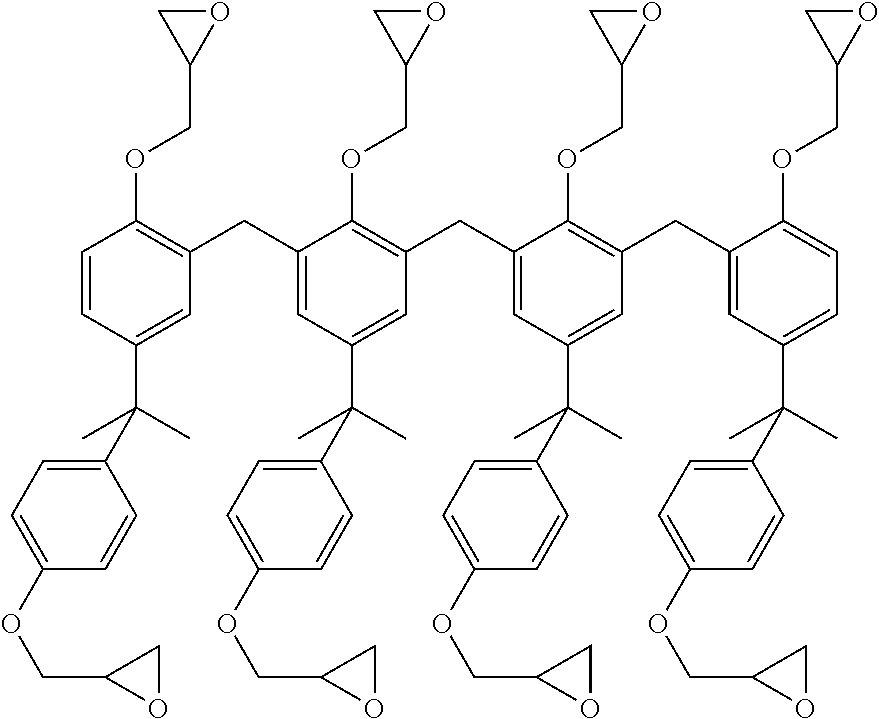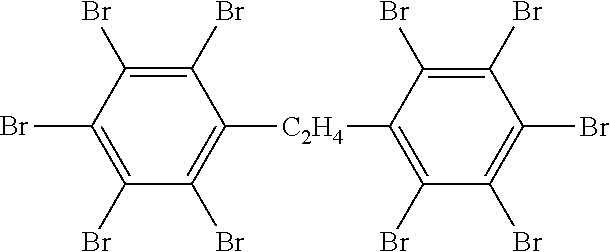High Tg Epoxy Formulation with Good Thermal Properties
a technology of thermal properties and epoxy, applied in the field of high-tg epoxy formulations with good thermal properties, can solve the problems of expensive varnish ingredients, and achieve the effects of reducing the incidence of pad cratering, less mechanical stress, and reducing mechanical stress
- Summary
- Abstract
- Description
- Claims
- Application Information
AI Technical Summary
Benefits of technology
Problems solved by technology
Method used
Image
Examples
example i
[0047]A varnish having the following formulation was combined with 15-45 parts of dimethylformamide (DMF) solvent.
TABLE 1ComponentVarnish Formula -Nameparts (wt %)Saytex 8010Brominated Flame retardant -36 (18.1%)decabromodiphenylethaneMegasil 525Crystalline silica filler39 (7.3) XZ 92757 X75Glicydyl ether of a bisphenol A105 (33.3%) novolac (having 8 functionalgroups)Epon 1031 A70Multifunctional epoxy (tetra-45 (14.3%)functional)DER 383 B90Bi-functional epoxy45 (14.3%)4,4′DDSAromatic amine36 (11.4%)Nipol rubberRubber1.9 (0.6%) BF3—MEALewis Acid2.4 (0.7%) Totals315.1 (100%)
[0048]The varnish was used to impregnate a woven sheet of “e” glass. However, alternatives to e glass such as “s” glass or “low Dk”“quartz” woven and / or matte glass cloth can be used.
[0049]The impregnation was performed manually. The woven glass cloth was dipped in the varnish for a period of time ranging from about 5 seconds to about 60 seconds then the solvents were driven off in a forced air oven for 1 to 5...
example 2
[0051]The following varnishes A-H were prepared according to Table 4 below:
TABLE 4ABCDEFGHComponent(parts)(parts)(parts)(parts)(parts)(parts)(parts)(parts)Bi-41.6385429.2300112.161.8FunctionalDERDERDERDERDERDERDER3EpoxyGlycidyl Ether Epoxy14.131.7218.340.2XZ9XZ9XZ9XZ9Hardener10010030.339.9100100100100BENABENABENBBENBDDSDDSBENBBENBHardener100100SMASMAIn Table 4;SMA = styrene maleic anhydride;BENA = benzoxazine based upon phenolphthalein;BENB = benzoxazine based upon bisphenol-A;DDS = 4,4′-diaminodiphenylsulfone;DER = DER383 a bifunctional epoxy resin;XZ9 = XZ92757 - an 8 functional glycidyl ether epoxy resin.
[0052]The ingredients of varnishes A-H above were combined with the solvent DMF and a Lewis acid (BF3-MEA) to form a thermosetting varnish. Each varnish was used to impregnate a woven sheet of “e” glass. The impregnation was performed manually. The woven glass cloth was dipped in the varnish for a period of time ranging from about 5 seconds to about 60 seconds then the solvents w...
PUM
| Property | Measurement | Unit |
|---|---|---|
| weight ratio | aaaaa | aaaaa |
| DMA Tg | aaaaa | aaaaa |
| pressure | aaaaa | aaaaa |
Abstract
Description
Claims
Application Information
 Login to View More
Login to View More - R&D
- Intellectual Property
- Life Sciences
- Materials
- Tech Scout
- Unparalleled Data Quality
- Higher Quality Content
- 60% Fewer Hallucinations
Browse by: Latest US Patents, China's latest patents, Technical Efficacy Thesaurus, Application Domain, Technology Topic, Popular Technical Reports.
© 2025 PatSnap. All rights reserved.Legal|Privacy policy|Modern Slavery Act Transparency Statement|Sitemap|About US| Contact US: help@patsnap.com


